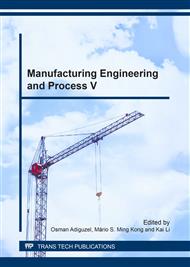[1]
D.A. Miller and D.C. Lagoudas: Thermomechanical characterization of NiTiCu and NiTi SMA Actuators: influence of plastic strains, Smart Mater. Struct. Vol 9 (2000), pp.640-652.
DOI: 10.1088/0964-1726/9/5/308
Google Scholar
[2]
S. Nemat-Nasser and W.G. Guo: Superelastic and cyclic response of NiTi SMA at various strain rates and temperatures, Mechanics of Materials Vol 38 (2006), pp.463-474.
DOI: 10.1016/j.mechmat.2005.07.004
Google Scholar
[3]
M. Ho and J.P. Desai: Characterization of SMA Actuator for Applications in Robotic Neurosurgery, 31st Annual International Conference of the IEEE EMBS Minneapolis, Minnesota, USA, (2009).
DOI: 10.1109/iembs.2009.5333118
Google Scholar
[4]
T.W. Duerig, K.N. Melton and D. Stockel: Engineering Aspects of Shape Memory Alloys, (Elsevier 1990).
Google Scholar
[5]
S.W. Robertson, A.R. Pelton and R.O. Ritchie: Mechanical Fatigue and Fracture of Nitinol, International Materials Reviews Journal of Materials Engineering and Performance Vol 57 (2012), pp.1-36.
DOI: 10.1179/1743280411y.0000000009
Google Scholar
[6]
L. Fumagalli, F. Butera, and A. Coda: SmartFlex NiTi Wires for Shape Memory Actuators, Journal of Materials Engineering and Performance Vol 18 (2008), pp.691-695.
DOI: 10.1007/s11665-009-9407-9
Google Scholar
[7]
C. Calhoun, R. Wheeler, T. Baxevanis, and D.C. Lagoudas, Actuation fatigue life prediction of shape memory alloys under the constant-stress loading condition, Scripta Materialia Vol 95 (2015) pp.58-61.
DOI: 10.1016/j.scriptamat.2014.10.005
Google Scholar
[8]
E. Williams and M. H. Elahinia, An Automotive SMA Mirror Actuator: Modeling, Design, and Experimental Evaluation, Journal of Intelligent Material Systems and Structures Vol 19 (2008), pp.1425-1434.
DOI: 10.1177/1045389x07087328
Google Scholar
[9]
M.E. Mitwally and M. Farag: Effect of cold work and annealing on the structure and characteristics of NiTi alloy, Materials Science and Engineering A Vol 519 (2009) pp.155-166.
DOI: 10.1016/j.msea.2009.04.057
Google Scholar
[10]
X. Huang and Y. Liu: Effect of annealing on the transformation behavior and superelasticity of NiTi shape memory alloy, Scripta Materialia Vol 45 (2001) pp.153-160.
DOI: 10.1016/s1359-6462(01)01005-3
Google Scholar


